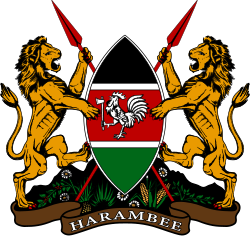 |
|---|
|
|
Economic schemes |
General elections were held in Kenya in September 1944.
 |
|---|
General elections were held in Kenya in September 1944.
Nominations were required to be presented by 20 July 1944. Fewer candidates than expected ran in the elections, with only four of the eleven European seats contested. [1] Of the seven unopposed candidates, six were members of the previous Legislative Council and one (Walter Trench) was a new member, replacing the retired Francis Scott. [1]
In Mombasa, sitting Councillor George Nicol called for Kenya, Uganda and Tanganyika to be united. [2]
| Constituency | Candidate | Votes | % | Notes |
|---|---|---|---|---|
| European seats | ||||
| Aberdare | Ernest Hay Wright | 173 | 49.1 | Re-elected |
| Arthur Sutcliffe | 83 | 23.6 | ||
| Jack Hopcraft | 75 | 21.3 | ||
| Edward Vaughan Kenealy | 21 | 6.0 | ||
| Coast Province | Shirley Victor Cooke | Unopposed | Re-elected | |
| Kiambu | Olga Watkins | 358 | 60.9 | Re-elected |
| Gerald Anderson | 230 | 39.1 | ||
| Mombasa | George Nicol | 192 | 68.1 | Re-elected |
| Granville Roberts | 90 | 31.9 | ||
| Nairobi North | Ferdinand Cavendish-Bentinck | Unopposed | Re-elected | |
| Nairobi South | Albert Vincent | Unopposed | Re-elected | |
| Nyanza | Frank Couldrey | Unopposed | Re-elected | |
| Rift Valley | Walter Trench | Unopposed | Elected | |
| Trans Nzoia | Albert George Keyser | Unopposed | Re-elected | |
| Uasin Gishu | W A C Bouwer | Unopposed | Re-elected | |
| Ukamba | Frank de Vere Joyce | 145 | 62.0 | Elected |
| Ewart Grogan | 89 | 38.0 | Defeated | |
| Indian seats | ||||
| Central | S K Thakore | 4,020 | 31.2 | Elected |
| Shams-ud-Deen | 3,811 | 29.6 | Re-elected | |
| S G Amin | 2,736 | 21.2 | Defeated | |
| Alex de Souza | 2,286 | 17.3 | ||
| Abdul Rahman Cocker | 41 | 0.3 | ||
| Eastern | K R Paroo | 4,918 | 43.0 | Re-elected |
| Ambalal Bhailalbhai Patel | 4,653 | 40.7 | Re-elected | |
| Mohamed Ali Rana | 1,870 | 16.3 | ||
| Western | Ahluwalia Pritam | 1,980 | 50.0 | Elected |
| Ibrahim Nathoo | 1,227 | 31.0 | ||
| Dharm Bir DauletRam Kohli | 750 | 19.0 | Defeated | |
| Source: East Africa and Rhodesia [3] | ||||